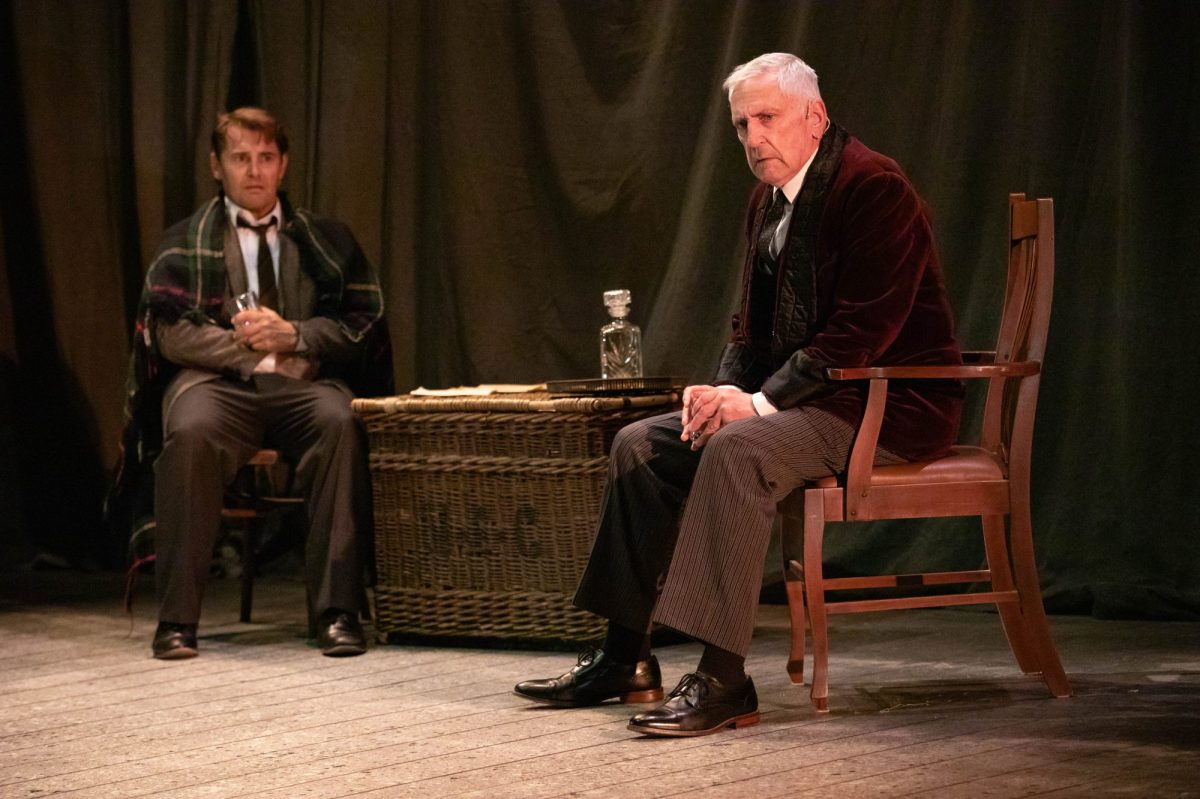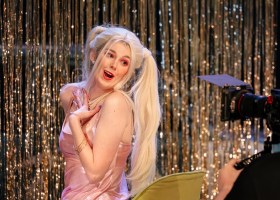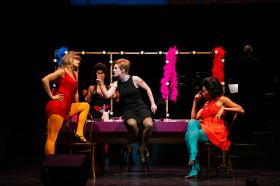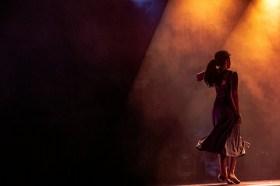The following review was first published when this production premiered in Brisbane. As it’s currently touring around the country, we’re resharing it for Melbourne audiences’ benefit.
Written in 1983, Susan Hill’s Gothic novel, The Woman in Black, was adapted for the stage by the late Stephen Mallatratt and has just completed a 33-year run in the London West End. It is that city’s second longest-running play after Agatha Christie’s The Mousetrap. A multi award-winning play, The Woman in Black has now played to over seven million theatre-goers.
True to its gothic genre, this is a gripping ghost story, using theatrical tricks and ingenious devices to create an imagined world of fear and terror. Brilliantly adapted by the Mallatratt, the play offers a richly layered text with a well-crafted, ever-expanding storyline that draws the viewer in. Apart from some beautiful descriptive passages that set the respective scenes up well, the script is both sharp and witty and presents the various colourful characters with great aplomb.
The story is told through the first-person narration of Arthur Kipps (John Waters), who recounts a haunting ghost story from his early life. He hires an actor (Daniel MacPherson) to assist him in telling the story to his family, thus helping to put his demons behind him. As a young solicitor, Kipps was sent to oversee the funeral of Mrs Alice Drablow, a client of his firm, and the last member of her family. Set in north-east England, the home of the Drablow family is the eerie Eel Marsh House, where many mysterious secrets come to light.
Robin Herford, the original director of The Woman in Black, created the play as a modest Christmas show for the tiny Scarborough Theatre. The dozen characters in the book were reduced to a two-hander, the actors playing the variety of roles required. Herford called it ‘a cut-price stocking filler’ and the show’s design has never really changed since, despite its fame and West End kudos. In part, this economy of production may also be the rationale for its success, relying as it does on the audience’s imagination.
The stage is set as a play within a play, showing the theatrical processes of assuming different characters while recounting a strong and engaging narrative. Michael Holt’s design offers a bare theatre stage with flowing grey drapes, some basic furniture and a wicker basket skip, minimal props, plus a costume rack with sufficient clothing to represent a range of characters. A few projections of the funeral and of Eel Marsh House are well-realised, as are the upstage scenes of the graveyard and bedrooms. For the most part, however, atmosphere is created by lighting and sound effects.
The sound palette by Rod Mead and Sebastian Frost consists of a range of sound effects, such as the hooves of a pony and trap, a road accident, ghostly footsteps and taped screams of various degrees of intensity. These work quite well. There is no musical score to add atmospheric terror to the production, as might be the theatrical norm today. A musical soundscape may have added greatly to the drama of the play.
There is atmospheric lighting from designer, Kevin Sleep. This includes the various scenes in trains, houses and offices, as well as a dark, shadowy funeral and marshland lighting complete with fog.
The closed door in Eel Marsh House is brilliantly lit with an evocative red wash and corridor of shining light. The ghost-like imagery of the woman in black works well, though given the technology available to us today it could be more compelling and breathtaking.
Technically some of the cueing is ragged, and needs to be sharpened. When this reviewer attended, after a powerful revealing end to the play, the final lighting cue was unfortunately called too soon swallowing up a key moment.
Antony Eden as Associate Director has taken over the directing role from Herford for this production and has produced a well-delivered and tightly directed play. For the most part, the minimal staging still works well, though perhaps it is showing its age technically. Some modern additions to make it more polished for an audience that is well-used to genres including zombies, horror and noir films may have been welcome.
Nevertheless, this play is a gift for two first-rate actors and Waters and MacPherson are both excellent and energetic – splendid in their respective roles and offering finely nuanced performances.
Waters starts the play as the nervous, unassuming Kipps, a man wanting to tell his story but unsure of how to do it. His bumbling reading of the opening lines is laughable, offering a humorous start before we embark on his story. Later he swaps his real persona for a range of other characters, all beautifully researched, with different accents, walks and costume accoutrements to bring them vividly to life. His four distinct Yorkshire accents, denoting the class and stature of those characters, are exceptionally well-presented.
As The Actor MacPherson makes a fine foil to Kipps. He starts as a bombastic, over-the-top character attempting to coach Kipps to deliver his story to better effect, but then takes on the role himself, managing it with distinction. He has a charismatic and natural charm on stage that is as infectious as it is engaging. He plays The Actor with passion and commitment, and with a benign indulgence to Waters’ Kipps that really works.
The creation of a wonderfully funny invisible dog called Spider offers the audience some lighter moments in this dark story. Both actors pat and respond to Spider with great attention to detail.
Read: Book review: No Church in the Wild, Murray Middleton
In the past few years, we have seen a spate of British-generated Gothic horror plays hit our shores. Most recently this included Gaslight, alongside the current regional tour of The Mousetrap following its successful national tour last year. This genre of spooky tales of horror and suspense clearly attracts audiences and this cleverly inventive production of The Woman in Black is a show that should do extremely well on its national tour. It deserves every success.
PW Productions, Woodward Productions & Neil Gooding Productions
Present
The Woman in Black
Book by Susan Hill, adapted by Stephen Mallatratt
Playhouse Theatre, QPAC
Director: Robin Herford
Associate Director: Anthony Eden
Designer: Michael Holt
Lighting Design: Kevin Sleep
Original Sound Design: Rod Mead
Sound Designer: Sebastian Frost
Cast: John Waters, Daniel MacPherson
The Woman in Black will be touring nationally until 17 August 2024: Brisbane until 11 May, Adelaide 15 to 26 May, Melbourne 13 to 30 June, Canberra 9 to 14 July, Wollongong 17 to 21 July, Newcastle 23 to 27 July and Sydney 30 July to 17 August.






